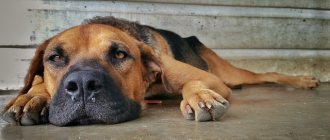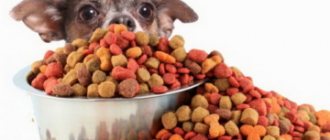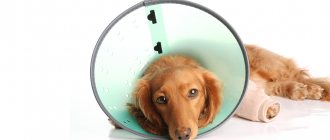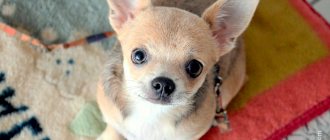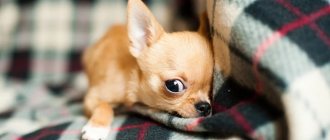General signs of the disease
The most striking harbingers of Chihuahua health problems are the following symptoms:
- elevated temperature – above the norm, which is 38-39 degrees;
- rapid breathing;
- the dog is vomiting;
- eyes water;
- discharge from the nose, ears;
- diarrhea;
- loss of appetite, even to the point of refusing food;
- weight loss;
- cough;
- presence of parasites;
- dandruff;
- itching;
- lameness;
- sudden convulsive attacks.
Symptoms and signs of a runny nose
Symptoms of rhinitis in dogs depend primarily on the factor that caused the changes in the body. Depending on what triggered the development of a runny nose in a dog, the intensity of the discharge, its consistency and color will differ. Common symptoms of rhinitis in pets are:
- the appearance of clear, yellow or bloody discharge;
- problems with the process of inhalation and exhalation;
- the appearance of sounds during sleep - snoring or snoring;
- constant rubbing of the muzzle area with paws to improve the breathing process;
- the appearance of drying crusts at the entrance to the nose (with a long-term runny nose);
- decreased appetite;
- sneezing and loss of smell;
- severe lacrimation.
In the absence of timely treatment, mucous discharge from the nose becomes purulent, sometimes with blood streaks. The mucous membrane of the nasal passages is severely hyperemic and swollen. Such signs directly indicate a long course of rhinitis.
Due to problems with the sense of smell, the pet loses a lot of weight, cracks and crusts are observed near the nose. The general condition of the pet is depressed. Chronic rhinitis develops.
With the follicular form of rhinitis, specific growths appear in the area of the mucous membranes covering the nasal passages. Over time, they fall off, and ulcers form in their place. It is prohibited to tear off or pick off growths on your own. As a result, this can cause infection and the development of dangerous complications.
A veterinarian will help you establish an accurate diagnosis and the cause of rhinitis in your pet. In the clinic's inpatient setting, all necessary studies are carried out to determine the type of disease, form and stage of its course.
Physiological features
Representatives of the smallest dog breed in the world have some distinctive qualities. But among them the most significant structural features can be identified:
- Presence of fontanel. Chihuahua puppies are born with a fontanelle, a non-fusion of the skull bones. This feature is inherent in many dogs of decorative breeds that have thin bones. The fontanelle has almost the same characteristics as those of human babies, and it also closes completely as the animal matures. But due to the softness of the bone structures, in some individuals it remains open throughout their lives. In most cases, a small moler does not affect the health of your four-legged friend, but experts classify its presence as a breed defect.
- The shape of the muzzle and the structure of the nasopharynx. Chihuahuas have a pointed muzzle, and the nasopharynx is designed in a special way, which leads to difficulty breathing, and the dog begins to make sounds similar to snoring.
A dog may grunt in the following cases: when running fast, against the background of strong excitement caused by positive or negative emotions, due to nasal congestion, congenital pathologies. In addition, a dog may grunt when he is in a hurry while eating, absorbing food at an incredible speed, or while walking, when a strong tug causes the leash to be pulled tighter than usual.
Another nuance - Chihuahuas are often real snorers and at night they are capable of producing real roulades. This should not worry the owners, as it is a natural process.
More often than not, grunting does not harm the well-being of a tiny pet. When it occurs, the owner is recommended to attract the attention of his four-legged friend by clapping his hands or offering him a piece of treat.
Owners of decorative miniature dogs should be wary if the dog begins to grunt more often than usual, and at the same time it seems that he is suffocating. In this case, the pet needs to consult a veterinarian, since reverse sneezing syndrome manifests itself in a similar way. This phenomenon can occur in dogs of any breed, but is more common in Chihuahuas, Beagles, French Bulldogs, Pugs, Toy Terriers and Yorkies.
How do Chihuahuas' teeth change?
Chihuahua puppies are born deaf, blind and toothless, and after 12-14 days their first baby teeth grow. At 45 days, they have already formed 28 milk teeth (6 premolars and incisors, as well as two canines). There may be a little less teeth (for example, 5 incisors), but this is not considered a serious deviation.
Teeth begin to change at 4-5 months (this depends on the size of the puppy - the smaller the dog, the later the teeth will appear). In this case, the incisors erupt by 6 months, premolars and molars by 7 months, and canines by 8 months.
In order for your Chihuahua to grow strong teeth, it is important to feed the dog properly.
Eye diseases
The Chihuahua has slightly protruding eyes that are larger than those of many dogs. Due to this unusual shape of the eyeballs, symptoms of many eye diseases can often be found in dogs of this breed:
- keratoconjunctivitis is a disease that causes dry eyes;
- glaucoma is a disease that develops due to increased pressure inside the eyeball;
- cataract is clouding of the lens.
If your dog's eyes are watery or running, redness is visible, he constantly blinks and rubs his eyes, and his eyes become too dull in color, then he is showing signs of eye disease.
What to do: urgently contact a veterinarian-ophthalmologist. He will conduct the necessary diagnostics and prescribe treatment. The main thing is to be on time, otherwise serious consequences may arise, from the need for surgical intervention to complete blindness.
Chihuahuas sometimes lose their eyes. This pathology can occur if the pet's head has been subjected to mechanical damage. Representatives of this breed have a shortened skull structure, and the eyeballs last only for centuries, so eye loss is a common occurrence.
The most striking symptom of this problem is protrusion of the eye. If the eyes are watering, bleeding, and the dog is afraid of light, then before going to the hospital you need to take some measures.
First, you need to keep the dog calm and try to keep his paws away from his eyes. A special collar or suitable clothing is perfect for this purpose.
Second, gently wipe the affected eye with saline solution. No antiseptics: no alcohol, no hydrogen peroxide. After this, lubricate the eye with a large amount of suitable ointment - tetracycline or floxal.
Third, apply something cold for fifteen minutes to relieve swelling. Then cover the damaged area with a wet cloth.
What is reverse sneezing
This syndrome, also called reverse sneezing, can seriously frighten the dog owner, which is not surprising - the dog begins to take quick, convulsive breaths, during which he makes grunting sounds. In this case, the dog can strongly stretch its neck, straining the muscles of the chest, arch its back like a house, leaning on its front limbs, and even lie down on its tummy.
The duration of the attack most often does not exceed one minute, and before its onset, as well as after its end, no changes in behavior are noted. If the syndrome does not lead to complications, why should owners pay attention to this phenomenon?
First of all, it all depends on the cause of reverse sneezing. Veterinarians were unable to establish them for certain, but there are a number of assumptions. The syndrome occurs:
- against the background of an overexcited nervous system;
- due to inhalation of small foreign objects: dust particles, pollen, fungi, dust mites;
- due to the animals inhaling rich, pungent odors;
- due to anatomical defects in the structure of the nasopharynx;
- hypertrophy of the tissues of the soft palate can lead to disruption;
- against the background of an allergic attack;
- for diseases caused by viral infection (parainfluenza, adenovirus, etc.).
What should owners of dogs prone to reverse sneezing do? In what cases is it necessary to consult a doctor?
How often does a Chihuahua go into heat?
Small dogs like Chihuahuas always need the care and love of their owners. But when they go into heat, they require a lot more attention. This happens in the first 18-20 months of life, lasts about 3 weeks and is repeated twice a year (the specific time depends on the characteristics of the dog’s body, its breed and conditions of detention).
The initial signs of this psychophysical condition can be noticed almost immediately by changes in the pet’s behavior. The Chihuahua will begin to mark its territory (naturally, it will choose an apartment for its puddles), become overexcited, very playful, and may even react aggressively to other dogs. But do not rush to take the animal to mating. Owners of young Chihuahuas should know that the pet’s body will be ready for procreation only after two heats, no less.
There are several ways you can help your furry friend cope with heat:
- take him to mating (for owners of purebred Chihuahuas this is not a problem at all, since there is always a “groom” in mind);
- use one of the drugs to regulate sexual activity (after taking them, the dog’s reproductive function will not be affected);
- sterilization (perhaps this is the most extreme and inhumane method - after such an operation the dog takes a long time to recover and experiences a lot of stress).
Trembling in a Chihuahua is considered quite common, but sometimes it can indicate the presence of diseases or disorders in the dog’s body. Possible reasons could be:
- decreased blood sugar (this is often indicated by morning tremors. The problem can be solved by reviewing the dog’s diet and giving up sweet and junk food. Regular exercise and eating high-quality food will also help);
- lack of calcium (appears during lactation. Prevention will be the consumption of foods high in calcium);
- pain in the ears (in this case the dog does not tremble with the whole body, but only with the upper part);
- cold (if the dog is cold, shivering helps to increase metabolism and warm up a little. Chihuahuas cannot be overcooled because they do not have an undercoat);
- strong excitement or fear (many Chihuahuas tremble when something unusual and new happens to them, when they are waiting for a treat or are simply very happy);
- excess energy (Chihuahuas are very energetic and can often tremble for this reason alone).
We suggest you read: Hip dysplasia in German Shepherds
For the most part, trembling is not a big deal for Chihuahuas. With its help they express their emotions.
Unexplained cough
If your pet is coughing, there may be several reasons. The unusually short structure of the head of Chihuahua dogs does not allow them to breathe deeply, especially during a sharp transition from a calm state to an excited one.
This is a common occurrence for such dogs; there is no need to worry at such moments. Distract the baby, calm him down - gently pick him up and stroke him. If it doesn’t help, close its spout with your hand for a few seconds to equalize the air pressure.
But if coughing attacks become more frequent, consult a doctor. Your dog may be having an allergic reaction to an external irritant or contracting a viral infection.
When should you take your dog to the clinic?
If reverse sneezing occurs once and does not happen again, and the dog itself feels as usual, then emergency measures are not required. The owner can visit the clinic for preventive purposes and to find out if there is any reason for concern. In some cases, such vigilance makes it possible to diagnose very serious illnesses, for example, brachycephalic syndrome, at an early stage.
If attacks of the syndrome become regular, the dog sneezes several times a day, it will not be possible to avoid consulting a veterinarian. Especially if the sneezing becomes longer and repeats more often each time. In this case, the pet’s condition may indicate the presence of a concomitant disease, and reverse sneezing is its complication.
If sneezing is accompanied by coughing, nasal discharge, mucous membranes become bluish, and the pet loses consciousness, we are talking about a critical condition. Typically, a similar clinical picture is observed with respiratory or vascular failure, and these are very dangerous conditions that can lead to death.
Naturally, in case of serious illnesses, the dog requires competent treatment. But the owner should also know how to independently stop an attack of reverse sneezing.
How to examine a dog. Temperature measurement
If the owner notices frequently repeated sneezing and grunting in the dog, yellow and greenish discharge from the nasal ducts, and strange behavior, the dog needs to be examined.
If you suspect that there is something foreign in the nasal cavity or inflammation, you should carefully shine a flashlight and inspect the nasal passages. Be sure to feel the nose; in a healthy dog it should be wet and cold.
Instructions on how to take a dog's temperature
https://www.youtube.com/watch?v=V3d8JeBL0_g
The gums of a healthy dog should not be dry or warm (such signs may indicate infection with a virus).
The normal appearance of the mucous membranes is approximately the same as in humans: uniform in color, shiny, moist.
If a dog has a fever, the owner will feel it throughout the body. You should feel the dog’s body in different places.
If your dog is sneezing due to a foreign object getting into its nose, and this was discovered during examination, you can try to remove it yourself. You may need to ask someone to hold the dog. Using narrow tweezers, you can remove the object from your pet's nose.
You can remove a foreign object from a dog’s nose yourself only if it is nearby
How to relieve a simple runny nose:
- If breathing is impaired, you can remove the discharge with cotton swabs, moistening them in warm water.
- If a crust has formed on the nose, it is removed using chamomile infusion, soaking the problem areas. To prevent crusts from appearing again, you need to anoint the skin with Vaseline.
- Sometimes ordinary nasal drops help, but only with herbal contents (Pinosol).
- If the pet also has a cough, some owners successfully drink warm milk and honey to soften the throat.
- Doctors advise adding vitamins A and E to your dog’s food.
It should be noted that with a “stuffy” nose, it will be easier for the dog to eat liquid, warm food.
Other cases will require the participation of a qualified physician. Especially with fever, refusal to eat, or fainting.
Sudden seizures
Regular uncontrollable seizures in Chihuahua dogs with possible loss of consciousness are caused by epilepsy. Epilepsy occurs due to a malfunction of the dog’s brain.
Epilepsy can be either hereditary or acquired. This disease is incurable, and the number of attacks only increases over time. Epilepsy begins to manifest itself between ten months and three years.
Seizures of epilepsy can be noticed in advance: the Chihuahua suddenly begins to get nervous, becomes timid and tries to hide somewhere.
When an epileptic seizure begins, the animal first falls sideways and the body becomes stiff. Then drooling occurs, and involuntary bowel movements occur in the bladder and intestines. The dog constantly moves its jaw, howls and twitches its paws. The attack can last a maximum of ninety seconds.
To suppress an epileptic attack, it is necessary to use special medications, such as Phenlepsin or Hexamidine.
First aid
Before taking any action, you should find out exactly what triggered the attack. First of all, you should look into the dog’s mouth to make sure there are no foreign objects there. If the owner discovers anything, it is necessary to unlock the dog’s jaws and use your fingers to pull out of the mouth what is stuck in it. Most often, Chihuahua owners cope with this task on their own, without resorting to outside help.
If there are other symptoms of the disease: blueness of the tongue, mucous membranes, etc., then you should not waste time eliminating grunting. It is important to immediately take your pet to the clinic or call a doctor at home. You can stop an attack of the syndrome in the following ways:
- The dog should be placed on an area with a hard surface so that the dog can rest on four paws at once and arch its back;
- It is most convenient to hold the baby under the tummy;
- lightly pat the chihuahua's throat with your palm and stroke its surface in a circular motion - this will provoke the act of swallowing;
- if this does not give the expected result, you should pinch both of the dog’s nostrils with your fingers for a few seconds and then release, giving the pet the opportunity to take a deep breath;
- You can offer your pet some water.
But even if the owner does nothing, seeing his dog sneeze, the attack will stop on its own without harming his health. If nothing is stuck in the dog's throat, his breathing will soon normalize and become normal.
What to do if your Chihuahua has diarrhea?
This condition of the pet should not be ignored. It can be caused by the following reasons:
- the presence of worms in the body (if there are a lot of them, the intestines become inflamed, which is accompanied by diarrhea);
- food poisoning (usually stale dry food or meat);
- overeating (including the reaction of the dog’s body to sweet, fatty, fried and smoked foods, which are contraindicated for Chihuahuas);
- various allergic diseases (to food, new food and even water).
During diarrhea, the owner must especially carefully monitor what the Chihuahua eats and in what portions in order to identify and remove allergenic foods from the diet. For 24 hours after the onset of diarrhea, the animal should be given only water, and from the second day you can feed the dog boiled rice in small quantities. You can return to regular food only after the dog has recovered.
Diarrhea, accompanied by loss of appetite, vomiting and a significant deterioration in the dog’s condition, is infectious and requires observation of the animal by a veterinarian (in such cases, an IV is placed to avoid dehydration).
Constipation is defined as difficulty or absence of bowel movements for several days. Most often, constipation occurs in sedentary animals that are fed the wrong food (tubular or boiled bones, strong broth, indigestible fiber) or too often. Dry food that is not suitable for a particular animal also causes constipation.
You can help your dog in this situation with good old kefir (a couple of teaspoons will be enough), vegetable oil (ideal with boiled carrots, but it can also be added to food), lactulose product (such as Duphalac), and Vaseline oil. If none of this helps, you can gently administer an enema.
We suggest you read: How to remove worms from a cat at home
Unpleasant smell
If your Chihuahua has bad breath, it could be a symptom of the following conditions:
- pulpitis – inflammation of the teeth;
- caries – tooth decay;
- periodontitis – destruction of the base of the tooth followed by the appearance of a cyst in the oral cavity;
All these diseases are preceded by the appearance of plaque and tartar. And as a result - bad breath.
What can you do to get rid of bad breath from your dog? You need to give her special substances that can neutralize the smell. Parsley oil or anise will do a great job with this. Treats containing chlorophyll or bacteria will also help with this smelly problem.
The body's protection of the respiratory system
A sneeze is a body reaction by which the body tries to get rid of something foreign. Sometimes dogs are bothered by smells that are completely acceptable to humans. Tobacco smoke, dyes and fresheners can irritate the dog's mucous membrane and make him want to sneeze. You simply need to observe your dog for a while to identify the offending odor and remove it.
A single sneeze most likely means your dog wants to get rid of dust or flower seeds that have gotten into his sensitive nose. This phenomenon is not dangerous. But if a dog rubs its nose and shakes its head, then something has definitely gotten into its nose. In this case, you should remove the object yourself using thin tweezers, or take your pet to a doctor. Usually the dog resists, so the foreign body must be removed very carefully.
Trauma may be the reason why your dog sneezes and snorts. If your dog has an injury to its nose, it may sneeze frequently. Blood may also leak from the nose due to a scratch or bruise. This means that you need to see a doctor as soon as possible.
If your dog's nose is swollen and tears flow, this may mean that he has an allergy. If you do not see a doctor on time, a supposedly harmless allergy can turn into a dangerous disease: asthma or bronchial spasms. This condition can be life-threatening for your pet, so be sure to contact your veterinarian right away.
Other reasons
If your dog is sneezing and coughing, this may indicate hypothermia. It is for this reason that you should not neglect special warm clothing for dogs. The mucous membranes may turn pale, and blisters appear on frostbitten areas: usually the paws or the tips of the ears. This happens especially often with short-haired breeds. In this case, immediate assistance from a specialist is needed.
The reason why a dog sneezes often may be due to its breed. An artificially bred breed, such as a pug, may have a deviated nasal septum. Because of this, pugs sneeze more often than other breeds. Also, age-related problems can cause frequent sneezing. If your dog is elderly and sneezes frequently, he may have problems with the cardiovascular system.
Oral problems can also cause sneezing. Bacteria can accumulate in the mouth and nasal cavity due to tooth decay or gum problems. When a dog sneezes, it is trying to get rid of these bacteria. Therefore, it is important to monitor your dog’s diet to prevent caries and tartar. Tartar can also be removed in the veterinarian's office using ultrasound.
Protection against hypothermia of a dog’s lungs is a function of the internal surfaces of the respiratory organs; in addition, the external tissues of these organs include microcilia, which remove all excess that comes from the outside.
The work of eyelashes is sometimes disrupted, which may be due to:
- infectious diseases;
- irritating factors;
- animal injury;
- inflammation for various reasons.
As a result, the dog begins to sneeze and cough. It is better to consider the possible reasons in order, from the simplest.
Skin problems
Dandruff is one of the common health problems for Chihuahuas. Dandruff is a large number of white flakes that form on a dog's skin.
There can be several reasons for the appearance of dandruff:
- lack of balance in the dog’s diet;
- too dry skin;
- bad water;
- allergy to dry food;
- inappropriate shampoo.
If the Chihuahua has experienced severe stress, then dandruff will appear immediately and in huge quantities. The dog could also have picked up a hair mite, which caused itching and dandruff.
Vitamin A, preferably in its pure form, will help you cope with this unpleasant phenomenon. If, along with dandruff, you notice redness on the skin, or hair in these places begins to fall out, immediately contact your veterinarian for timely diagnosis and subsequent treatment.
Viral diseases
The most dangerous viral disease with a possible fatal outcome is canine distemper. If your pet is vomiting, has diarrhea, coughing, fever, sudden loss of appetite, and purulent discharge is flowing from the nose and eyes, take him to the doctor immediately.
Symptoms of viral hepatitis are diarrhea, high fever, inflammation in the nose, weakness of the hind limbs followed by convulsions.
If your Chihuahua is feverish and vomiting, bloody diarrhea and mouth ulcers are the first signs of a fever.
Parvovirus affects the digestive organs. If this disease has reached a severe stage, then in addition to lack of appetite, the dog constantly vomits.

